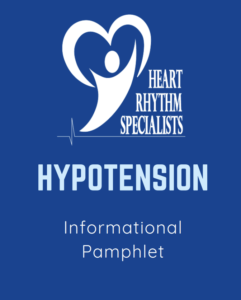What is Hypotension?
Hypotension is abnormally low blood pressure (below 90/60). There are several different types of hypotension, depending on when blood pressure drops. These include:
- Orthostatic hypotension: a sudden drop in blood pressure when standing up.
- Postprandial hypotension: a drop in blood pressure 1-2 hours after eating.
- Neurally mediated hypotension: a blood pressure drop after standing for a long period of time.

How is Hypotension Diagnosed?
Dr. Yoo will use a combination of
a physical exam, blood pressure
measurement, medical history, and
testing, which may include
- blood tests
- electrocardiogram (ECG/EKG)
- tilt table test
Risk Factors include:
- older age medications, such as high blood pressure medicine
- certain diseases, such as Parkinson’s disease, diabetes, and some heart conditions
Causes of Hypotension include:
- pregnancy
- impaired circulation
- endocrine disorders
- dehydration
- blood loss
- infection of the bloodstream
- severe allergic reaction
- lack of nutrients in diet
- certain medications, such as betablockers, diuretics, and more
Symptoms of Hypotension
Symptoms may include:
- fatigue
- dizziness or lightheadedness
- nausea
- clammy skin
- depression
- fainting (syncope)
- blurry or fading vision
- lack of concentration
Treatments for Hypotension
Typically, if low blood pressure causes little to no symptoms, treatment is not necessary. For patients with severe symptoms, treatment may include:
- increasing salt intake
- increasing water intake
- wearing compression stockings
- medication(s)
- eating small, low-carb meals several times a day
- regular exercise
Additional Resources
